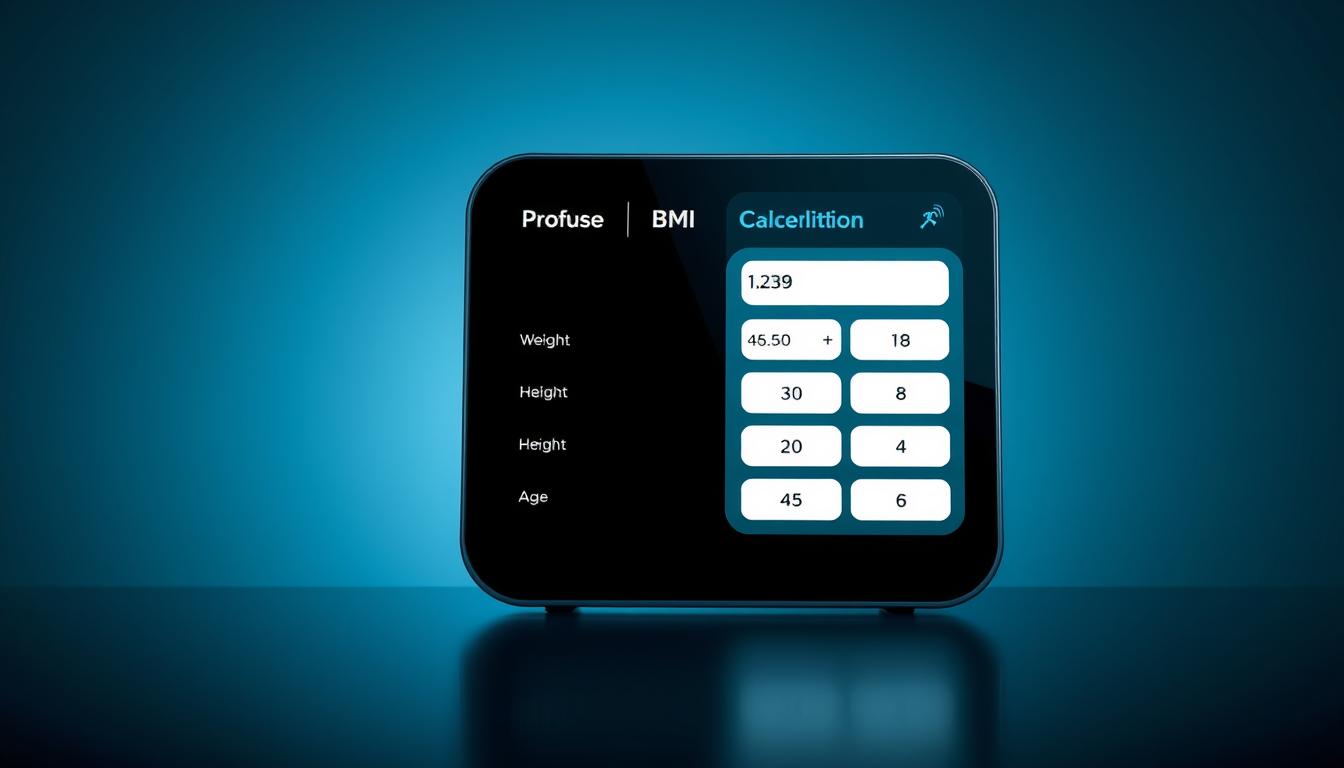“Strength does not come from physical capacity. It comes from an indomitable will.” – Mahatma Gandhi. For powerlifters, physical capacity is crucial, and understanding one’s body mass index (BMI) can be a fundamental aspect of assessing their health and performance.
As athletes, powerlifters often rely on metrics to gauge their progress. BMI is one such metric that provides a basic starting point. However, its limitations, particularly for strength athletes with high muscle mass, necessitate a deeper understanding.
We will explore the concept of BMI, its calculation, and its relevance to powerlifters. We’ll also discuss why traditional BMI might not accurately reflect the health status of strength athletes and introduce alternative metrics that could be more useful.
Key Takeaways
- Understanding BMI and its calculation
- Limitations of BMI for powerlifters and strength athletes
- The impact of muscle mass on BMI readings
- Alternative metrics for assessing body composition and health
- The importance of understanding BMI when communicating with healthcare providers
Understanding BMI and Its Purpose
The concept of BMI is straightforward, yet its application, especially among athletes like powerlifters, requires a nuanced understanding. BMI is calculated by dividing a person’s weight in kilograms by the square of their height in meters (kg/m²).
This formula was developed as a population screening tool to assess weight status across large groups, not as a diagnostic tool for individuals. As such, it provides a general indication of whether a person’s body weight is in a healthy range for their height.
What BMI Measures
BMI serves as a general indicator of whether a person’s body weight is in a healthy range for their height. It is a simple, widely used metric that applies to both men and women.
Standard BMI Categories
The BMI categories are defined as follows: underweight (BMI body weight and height.
Why Traditional BMI Calculators Fall Short for Powerlifters
The intense training regimens of powerlifters result in physiques that standard BMI calculators are not equipped to assess accurately. We will explore why traditional BMI calculators fall short for powerlifters.
The Muscle Mass vs. Fat Mass Problem
Traditional BMI calculators fail to differentiate between muscle mass and body fat. This limitation is particularly problematic for powerlifters, who typically have a high amount of muscle mass. As a result, their BMI may categorize them as overweight or obese, even if they have low body fat.
- Powerlifters have significantly more muscle mass than the average person.
- Muscle tissue weighs more than fat tissue, further skewing BMI results.
How Powerlifting Physiques Skew BMI Results
Powerlifting involves intense resistance training, which not only builds muscle but also increases bone density. This change in body composition is not accounted for in traditional BMI calculations. Consequently, elite powerlifters may be misclassified as “obese” according to BMI, despite having healthy body fat levels.
Understanding these limitations helps powerlifters better interpret their BMI results and look beyond this metric for a more accurate assessment of their health.
Using a BMI Calculator for Powerlifters
For powerlifters, using a BMI calculator can be a bit more complex than for the general population.
To accurately calculate your BMI, you can use the formula: BMI = your weight in kg ÷ (your height in m)². For instance, a man who is 1.75m tall and weighs 75kg would have a BMI of 24.5, falling into the normal weight category according to WHO criteria.
Step-by-Step Guide to Calculating Your BMI
We’ll walk you through a clear step-by-step process for calculating BMI using both metric and imperial measurements. This includes using online BMI calculators with powerlifting considerations in mind and recording your weight accurately for consistent BMI tracking.
Interpreting Your Results as a Powerlifter
It’s essential to understand that a “high” BMI for powerlifters may not indicate the same health risks as for the general population, due to their significant muscle mass. We’ll discuss how to track BMI changes over time and what fluctuations might indicate for powerlifters.
Adjusting BMI Expectations for Strength Athletes
The standard BMI ranges, while useful for the general population, may need adjustment when applied to strength athletes like powerlifters. For a large portion of the population, BMI accurately indicates whether someone has overweight or obesity and is at an increased risk of disease.
Healthy BMI Ranges for Powerlifters
Many healthy, competitive powerlifters fall into the “overweight” (25-29.9) or even “obese” (30+) categories. We can consider adjusted BMI ranges for active powerlifters based on their training experience and competition level. For instance, a powerlifter with significant muscle mass may have a higher BMI without being at a higher health risk.
- Beginner powerlifters: 20-25 BMI range
- Intermediate powerlifters: 25-28 BMI range
- Advanced powerlifters: 28-32 BMI range
When to Be Concerned About Your BMI
A high BMI might be cause for concern even for powerlifters if there are rapid increases or extreme values. It’s essential to differentiate between productive weight gain (muscle) and potentially problematic weight gain (excessive fat). Health markers beyond BMI should be the primary concern for strength athletes, including body composition and overall health.
Better Alternatives to BMI for Powerlifters
Powerlifters require a more nuanced approach to assessing their body composition than what traditional BMI calculators offer. While BMI can provide a general health indication, it fails to account for the muscular physique of powerlifters, often categorizing them as overweight or obese despite their low body fat.
Body Fat Percentage Measurements
Measuring body fat percentage is a more accurate way to assess health for powerlifters. This metric differentiates between lean mass (muscle, bone, organ, and fluid weight) and fat mass. For athletic men, a body fat percentage ranging from 5 to 13 is typical, while for women, it’s between 12 and 22 percent. Various methods can measure body fat percentage, including calipers, bioelectrical impedance, and DEXA scans, each with its own level of accuracy.
Understanding body fat percentage is crucial because it provides a clearer picture of health risks associated with excess fat. For powerlifters, maintaining an optimal body fat percentage is essential for both performance and health.
Waist Circumference and Waist-to-Hip Ratio
Beyond body fat percentage, waist circumference and waist-to-hip ratio are valuable metrics. Waist circumference measures visceral fat, which is directly linked to health risks. A larger waist circumference indicates higher health risks. The waist-to-hip ratio provides additional insight into body composition and health risk by comparing waist circumference to hip circumference. Proper measurement techniques are essential for accurate assessments.
These alternative measurements offer a more comprehensive understanding of body composition than BMI alone. By using a combination of body fat percentage, waist circumference, and waist-to-hip ratio, powerlifters can gain a better understanding of their health and make informed decisions about their training and nutrition.
Tracking Body Composition Changes During Training Cycles
As powerlifters progress through different training cycles, tracking changes in body composition becomes crucial for optimizing performance. This involves monitoring various metrics to ensure that changes in weight are aligned with training goals, whether it’s gaining muscle mass during bulking phases or reducing body fat during cutting phases.
Monitoring Methods During Bulking Phases
During bulking phases, the goal is to gain muscle mass while minimizing fat gain. To achieve this, powerlifters should track their weight regularly, as well as their body fat percentage. It’s also essential to monitor strength metrics to ensure that weight gain is translating into increased strength.
A useful method for tracking progress is to use a combination of measurements, including weight, body fat percentage, and strength metrics. This can be summarized in a table to visualize progress over time.
| Metric | Initial | Week 4 | Week 8 |
|---|---|---|---|
| Weight (lbs) | 200 | 210 | 220 |
| Body Fat Percentage | 20% | 21% | 22% |
| Squat (lbs) | 300 | 315 | 330 |
Assessing Progress During Cutting Phases
During cutting phases, the goal is to preserve muscle mass while reducing body fat. Powerlifters should continue to track their weight, body fat percentage, and strength metrics. A slow and controlled rate of weight loss is crucial to maintaining muscle mass.
As noted by strength training expert Jim Stoppani, “A rate of weight loss of 0.5-1% of body weight per week is ideal for preserving muscle mass during cutting phases.” This emphasizes the importance of patience and careful monitoring during cutting phases.
“A rate of weight loss of 0.5-1% of body weight per week is ideal for preserving muscle mass during cutting phases.” – Jim Stoppani
By closely monitoring these metrics and adjusting their diet and exercise routine accordingly, powerlifters can achieve their goals while maintaining overall health and performance.
Health Markers That Matter More Than BMI
For powerlifters, a more comprehensive approach to health assessment is necessary beyond BMI. While BMI can provide a general indication of health, it falls short in assessing the overall well-being of strength athletes.
Monitoring blood work and vital signs is crucial. Key parameters include blood cholesterol and sugar levels, as well as blood pressure. These markers help identify potential risks for heart disease and type 2 diabetes.
Blood Work and Vital Signs
Regular blood tests reveal important health information. Lipid profiles, blood glucose, and hormone levels are key indicators of health risks. Vital signs like blood pressure and resting heart rate provide insights into cardiovascular health.
Performance Metrics for Powerlifters
Tracking strength progression, recovery capacity, and energy levels helps powerlifters understand their physical condition. These performance metrics serve as indicators of overall health, enabling informed decisions about training and nutrition.
Making Informed Decisions About Your Training and Nutrition
A comprehensive approach to health assessment is necessary for powerlifters to ensure they’re making informed decisions about their training and nutrition. While BMI calculators can provide a general indication of health, they have significant limitations for athletes with high muscle mass.
By considering multiple factors, including body fat percentage, waist circumference, and overall lifestyle, powerlifters can better understand their health risks and make informed decisions. It’s essential to balance performance goals with long-term health considerations, recognizing that extremely low body fat or excessive body mass can have health implications.
We recommend that powerlifters consult with healthcare providers to get a more accurate assessment of their health and risks. By taking a comprehensive approach to health assessment, powerlifters can achieve their goals while minimizing their risk of disease and maintaining overall health.



